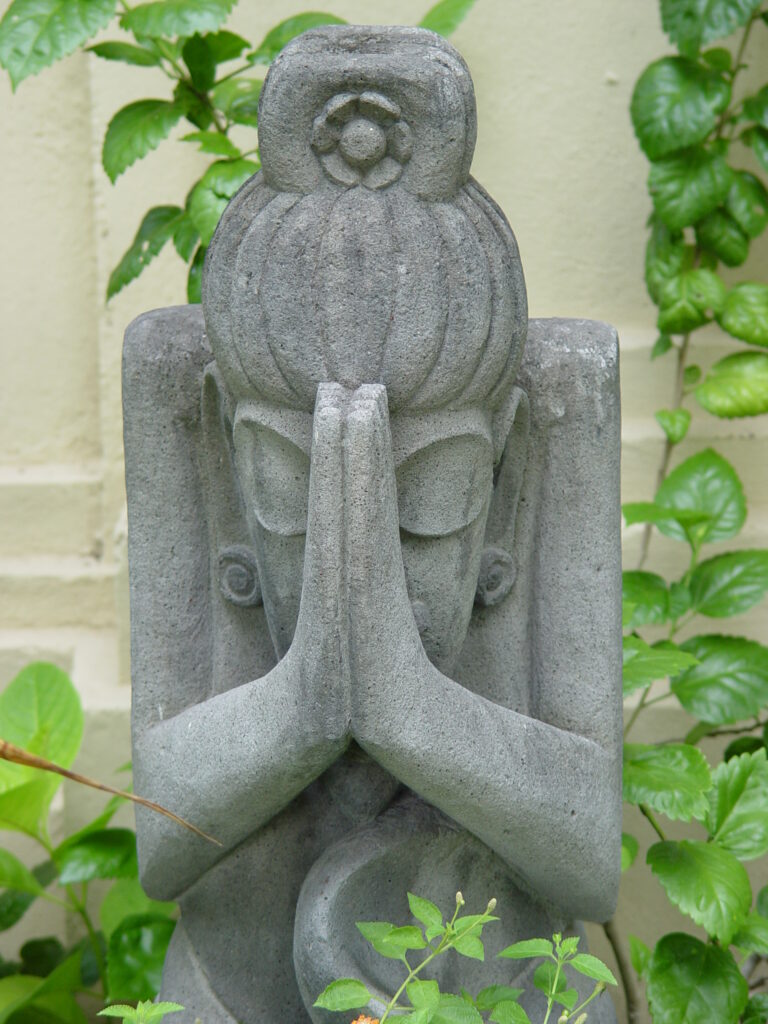
by: Aernoudt Knecht
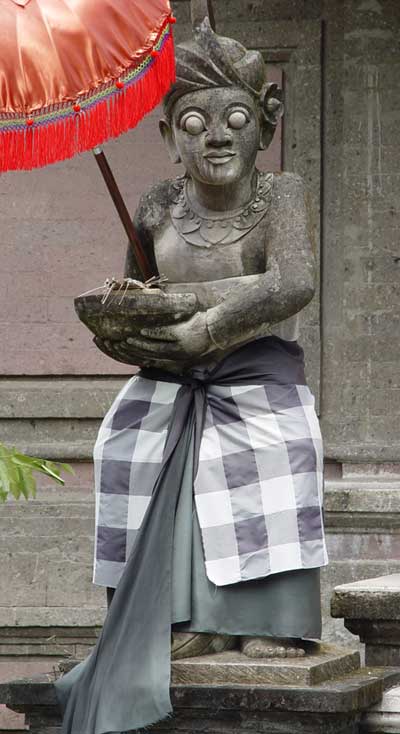
Surrounded by sacred relics, offerings and jars full of burning incense, in a village near Ubud, a priest sits on the plateau of his home temple praying. In his left hand he is playing a bell, and he repeats long mantras. It is March, very early in the morning, just after sunrise, and the fog from the previous night has not yet lifted. I’m in Bali, and the clear sound of the bell seems to indicate that the gods are present. The atmosphere in the temple is intensely peaceful. The balance between passion and tranquility that I feel here is typical for the island. Nowhere else have I ever experienced such a thing.
While the priest remains in an imperturbable state of ‘being’, there is a pleasant bustle around him. A group of women is busy making sure everything runs smoothly. Some visitors have gathered to be blessed, I am among them, and the women wash our hands with holy water. They receive our offerings, place them in the temple, and light the incense. A few days earlier, Sri, the wife of a priest, told me that in Bali only men can become priests and that priests usually have several wives. She assured me that she was happy that her husband has other women. After all, it is impossible for one woman to do all the work in a temple on her own. And now she still has time to do things for herself.
High on his plateau, the priest is still busy opening the ‘gates to heaven’. His eldest wife gestures to me, and four others, that we may sit on the bench in front of him. He interrupts his singing for a moment, puts the bell down next to him and takes the jug his wife hands him. As the priest begins to recite again, the woman shows me how to fold my hands. He pours water into my hands and she shows me when to drink and when to sprinkle the water over my head. He gives me rice and two flowers. I apply the rice – according to Balinese custom – to my forehead, and I put the flowers behind my ear.
I have been in Bali for several weeks now. Spirituality is visible everywhere. There are thousands of official temples, several in every village. Every family has its own house temple, and in every rice field there is a shrine. Even far from civilization, in the middle of the jungle, there are temples. From the moment I stepped out of the airport, I was surprised by impressive sculptures of gods and spirits. Everything is buzzing with energy and it seems that the stone sculptures can start moving at any moment.
Offering is the most important and visible religious activity in Bali. And it is the women who perform this ritual. In a special kind of meditative calm, they weave beautiful offering baskets from palm leaves in which they collect all kinds of things to offer: flowers, cookies, rice, tobacco… These offering baskets are offered, with plenty of incense, to the ancestors, the gods, the spirits, Buddha , the plants and the animals… Every day they express their respect and gratitude for every form of life and for the forces that influence their existence. You can keep thinking about life endlessly, but Balinese women teach me that spirituality is mostly about doing.
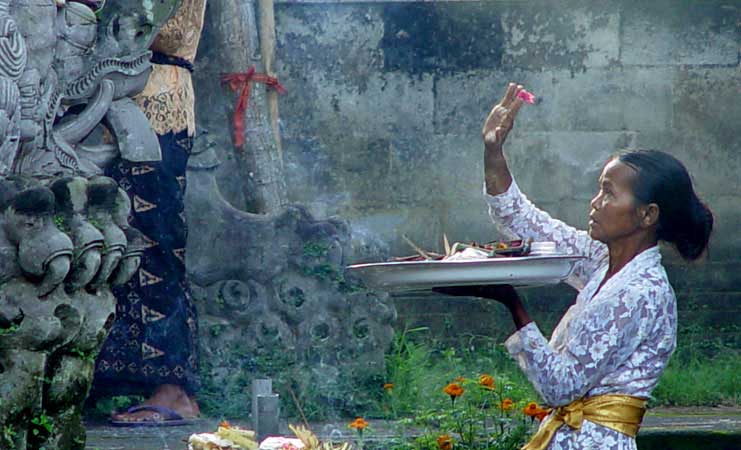
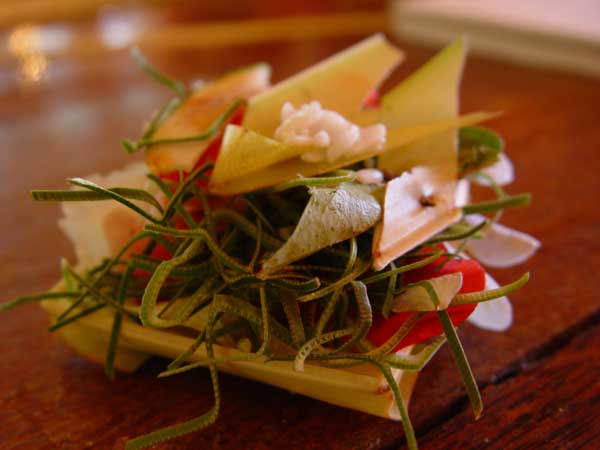
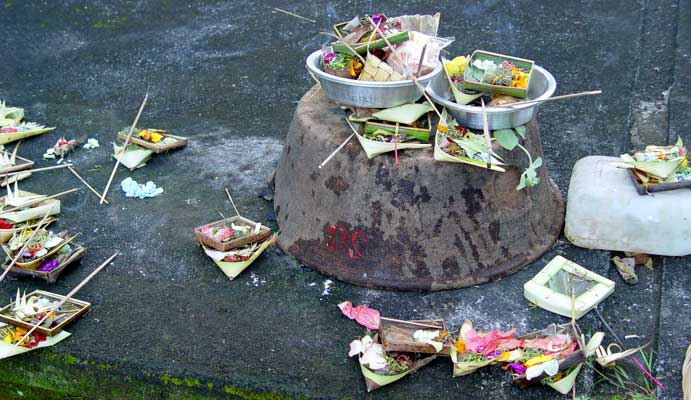
Whatever worldview or religious belief you hold, whether you believe in gods or not, it touches you when you see people honoring the fact THAT they exist, that they HAVE ancestors and that incomprehensible FORCES are at work in their lives. The presence of all those offering baskets in the temples, at the entrances of houses, on riverbeds, at crossroads, in shops, everywhere you go, makes you look at the world differently. Everything takes on meaning and power. Everything seems animated. Now that I’ve seen Balinese women at work, I understand why these sculptures seem so alive. They are charged daily with the energy of the offering women. Their attention and dedication play a big part in the magical atmosphere that permeates Bali.
Balinese people, by the way, do not judge reality from the concepts of ‘good’ and ‘evil’, but speak about lower powers and higher powers. Offerings are also made to the lower powers. Even though some powers are disruptive or destructive, in the balance of the greater whole there is no point in honoring one and ignoring the other. Balinese spirituality revolves around three forms of balance. Balance between man and man. Balance between man and world. And balance between man and the gods.
After the priest’s blessing, a late breakfast, and a visit to an internet cafe, I make my way to the place where I meet Darta. He will take me to a temple in another village. The family or clan that runs this temple gathers every Balinese year – which has 210 days – for a big ritual. Darta tells us that some men go into a trance state during this ritual so that the gods can pass on messages to the family through them.
When we arrive at the square in front of the temple in the early afternoon, there is already a buzzing of energy. People of all ages flock to the village to witness the ritual. Children, dressed in their most beautiful temple outfit, are already looking for a place on the temple wall to see everything. While the square fills up more and more, a large gamelan orchestra is playing melodious rhythms.
Every plateau of the temple is stacked with towering offerings, consisting of fruits, rice, cookies, and other tasty things. When the gods have accepted the offerings, they will serve as a feast for the family. In a corner of the temple, the young men of the clan, who will enter a state of trance during the ritual, are preparing together.
A procession of musicians and children with flags, followed by a line of women with offerings and the young men in their black and white checkered sarongs, make their way to the river to be blessed. All spectators patiently wait for their return. In Bali people have time.
The first women to return start preparing offerings at the entrance to the square. There’s a lot going on. Something is brewing between the women, the exact content of which escapes me.

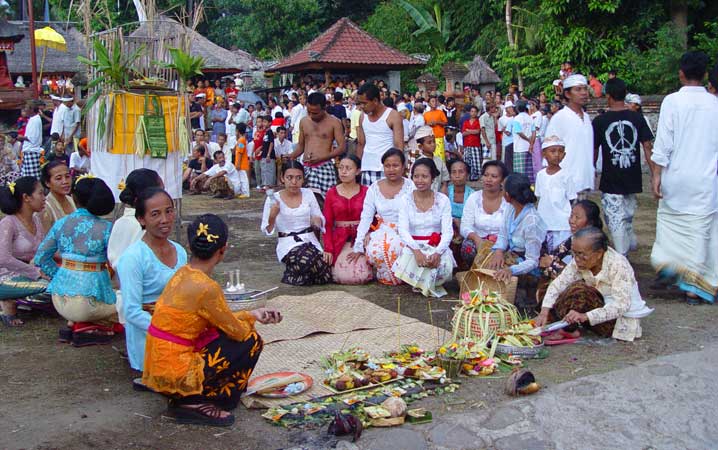
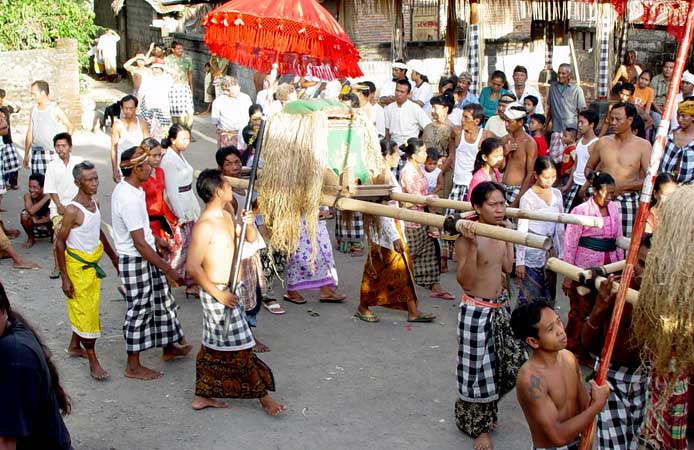
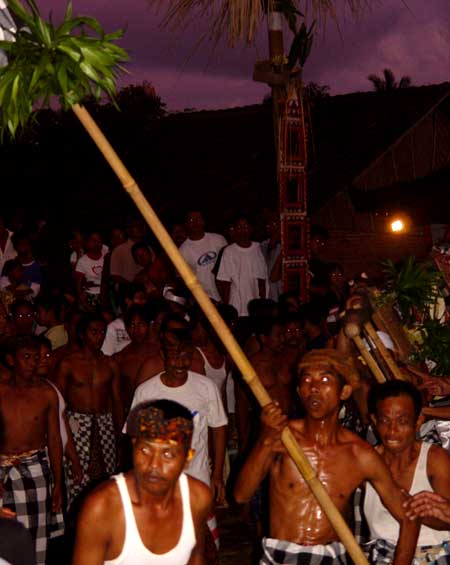
Every hole and wall of the temple square is filled with men, women and children. They don’t want to miss a moment of this ceremony. The gamelan slowly picks up the pace and more and more women of the clan gather in a semicircle in the temple square. The sight of the large group of Balinese women in temple dresses is breathtaking. Like a welcoming committee, they await the return of the men. The whole thing has been going on for hours now and the tension is building.
It is becoming increasingly clear to me that the men’s trance is only the most visible and spectacular part of the whole ritual. The men can only go into a trance if there is a sacred space that allows it. The stirring sounds of the gamelan and the crowd of expectant spectators in the square contribute to the build-up of the energetic field. And it is very clear to me that it is the women in the temple square who create the space and are the driving force behind the whole event!
At sunset the group of women in the square in front of the temple has grown so large that I lose the overview. The air is buzzing with energy and I can feel my heart beating faster. The gamelan’s music accelerates to a dizzying pace.
The first men storm into the square…